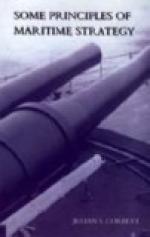(1) The selection of the “objectives,”
that is, the particular forces
of
the enemy or the strategical points to be dealt with
in order
to
secure the object of the particular operation.
(2) The directing of the force
assigned for the operation.
Minor Strategy may be of three kinds:—
(1) Naval, where the immediate
object is to be attained by a fleet
only.
(2) Military, where the immediate
object is to be attained by an army
only.
(3) Combined, where the immediate
object is to be attained by army
and
navy together.
NOTE.—It will be seen that what is usually called Naval Strategy or Fleet Strategy, is only a sub-division of a division of strategy, and that, therefore, strategy cannot be studied from the point of view of naval operations only.
NOTE.—Naval Strategy, being only a part of General Strategy, is subject to the same friction as Major Strategy, though in a less degree. Individual commanders have often to take a decision independently of the central government, or headquarters; they should, therefore, always keep in mind the possible ulterior effects of any line of action they may take, endeavouring to be sure that what is strategically expedient is not diplomatically inexpedient.
EXAMPLE.—Boscawen’s
attack on De la Motte on the eve of the Seven
Years War.
NATURE OF OBJECT
The solution of every strategical problem, whether of Major or Minor Strategy, depends primarily on the nature of the object in view.
All objects, whether ulterior or not, may be positive or negative.
A positive object is where we seek to assert or acquire something for ourselves.
A negative object is where we seek to deny the enemy something or prevent his gaining something.
Where the object is positive, Strategy is offensive.
Where the object is negative, Strategy is defensive.
EXAMPLE.—When Togo attacked Rojesvensky his primary object was offensive, i.e., to capture or destroy the Russian Fleet. His ulterior object was to maintain the defensive function which had been assigned to the Japanese Fleet.
NOTES.—This is
a good example of true defensive; that is, Togo’s
operations, though drastically
offensive in action, were all strictly
within the strategical defensive
sphere assigned to him.
The Offensive, being positive in its aim is naturally the more effective form of war (i.e., it leads more directly to a final decision), and, as a rule, should be adopted by the stronger Power.
The Defensive, being negative in its aim, is naturally the stronger form of war; i.e., it requires less force, and, as a rule, is adopted by the weaker Power.
NOTE.—The general
truth of this proposition is not affected by
apparent exceptions where
the contrary appears to be true.




